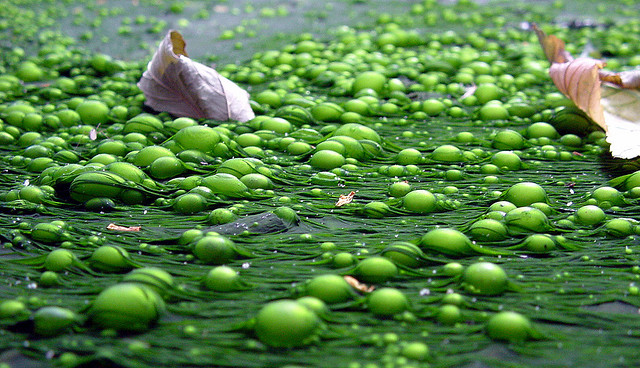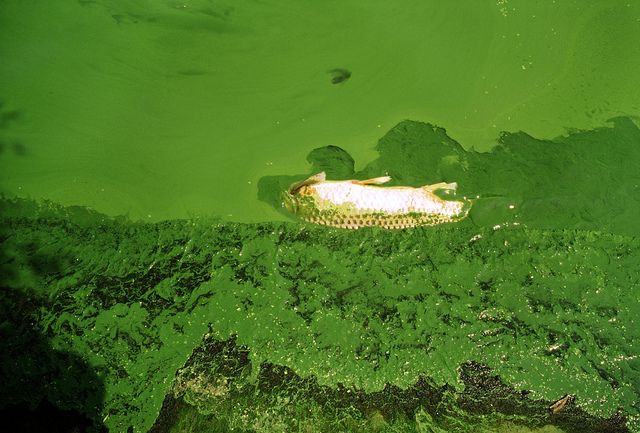
Algae having a par-tay today. It's nothing compared to the 5-million year bender they went on 250 million years ago. Creative Commons eutrophication&hypoxia
![]() About 250 million years ago in what is today the vast backwater of north central Siberia, the Earth coughed forth an unimaginable quantity of lava over the course of 1 million years. The liquid rock was a low-viscosity, thin stuff (for lava), so instead of forming a field of towering volcanoes it oozed out into endless plains. Covering some 1.5 million square kilometers today (600,000 square miles — something like the surface area of Europe), the beds may have originally covered 7 million square kilometers and taken up 1 to 4 million cubic kilometers in volume.
About 250 million years ago in what is today the vast backwater of north central Siberia, the Earth coughed forth an unimaginable quantity of lava over the course of 1 million years. The liquid rock was a low-viscosity, thin stuff (for lava), so instead of forming a field of towering volcanoes it oozed out into endless plains. Covering some 1.5 million square kilometers today (600,000 square miles — something like the surface area of Europe), the beds may have originally covered 7 million square kilometers and taken up 1 to 4 million cubic kilometers in volume.
Scientists still do not agree why this happened, although it has happened many times before and since around the world. But they do agree on the timing: it happened at the same time as the Great Dying — during the Permo-Triassic extinction just prior to the age of dinosaurs that wiped out more life on Earth than any other, including the one with the giant asteroid with our name on it.
Not all scientists agree that the Siberan Traps, as they are called (trap comes from the Swedish word for “stairs”, which is how the frozen lavas can appear today) chiefly caused the extinctions. But many do, and it seems to be solidifying (er, pardon the pun) as the majority opinion.
What is also known is that life took some time to recover from this cataclysm. For at least 5 million years after, we can find little in the fossil record. Scientists have wondered whether this was a case of too much or too little food.
How, you might ask, could too much be a problem? Well, visit your nearest pond contaminated by fertilizers from lawns, golf courses, or farms and you will see: vast swarms of algae, that hog all the oxygen and choke out “higher” forms of life like fish. Or, for that matter, the New-Jersey-sized Dead Zone in the Gulf of Mexico, which formed in response to the endless streams of fertilizer runoff from farms pumped into the sea by the Missouri, Mississippi, and Ohio River system. We call this eutrophication*, and now, the authors of a paper in in Earth and Planetary Science Letters are pretty sure it is what prevented most life from recovering for those five million long years.

What happens when the party gets a little too wild. A lake in China with rampant eutrophication. Creative Commons eutrophication&hypoxia
How might scientists figure this out? As it turns out, one of the enzymes that catalyzes photosynthesis has a quirk. Thinking back to high-school chemistry, recall that the nucleus of an atom is made of protons and neutrons. Different elements are defined by the number of protons their nuclei contain. Carbon *always* has six protons. If it had seven, it would be nitrogen. But elements can vary in the number of neutrons they have. Carbon, for instance, can commonly have six neutrons or seven. Carbon-12 represents the former, while carbon-13 the latter.
As it happens, one of the chief enzymes of photosynthesis — RuBisCO, the one responsible for grabbing carbon dioxide from air and setting it on the path to become glucose — processes carbon dioxide containing carbon-12 a little faster than carbon dioxide containing carbon-13. Over jillions of cycles, the difference accumulates, and life becomes enriched in carbon-12. It makes little or no difference to the organisms themselves.
But it makes a big difference to scientists, who can use this knowledge to tell how fast the oceanic biological pump — the transfer of carbon from the atmosphere and surface waters to the seabed by microorganisms that live, die, and sink — is churning. The more these microbes nom, the more carbon-12 builds up in preference to carbon-13 in seabed deposits, where marine algae sink, store carbon, and are eventually pressed into limestone after they die. Scientists who studied marine deposits recorded in Chinese rocks during this 5-million year gap have found the carbon-12 enrichment is about double what exists today. If life had starved after the Traps did their dirty work, they would expect to see the opposite.
This is the scenario the authors of this new paper believe may have happened: as they erupted, the Siberian Trap lavas and the rocks they metamorphosed by contact spewed carbon dioxide (as well as many other volcanic gases) into the atmosphere. This warmed the atmosphere, which increased the evaporation of water, itself a greenhouse gas, perpetuating the cycle.
At the same time, more water vapor produced more rain, which weathered the land quickly. All that runoff drove incredible quantities of phosphate — a nutrient that limits the rate at which marine algae can grow — into the ocean. With a new all-you-can-eat buffet of phosphate and carbon dioxide at their disposal, marine microbes went nuts. The ocean was stripped of free oxygen, preventing any animal life that had managed to survive the extinction itself from regaining ground. Once the initial trauma of the Permo-Triassic extinction was over, these algae must have bloomed in quantities unimaginable. What is now the Blue Planet, and once may have been the White Planet, was briefly, it seems, the Green Planet.
What finally stopped the madness (from our perspective as vertebrates), was the waning of the volcanoes. Eventually, carbon dioxide levels dropped, and warming and rainfall decreased. With less erosion, oceanic phosphate and nitrogen concentrations dropped. Without enough of these nutrients to go around, algal numbers shrank, leaving enough oxygen around for other forms of life to exploit. And, luckily for us, they did.
___________________________________________________
* Which is the reason you should all be using phosphate-free detergents.
![]()
Meyer, K., Yu, M., Jost, A., Kelley, B., & Payne, J. (2011). δ13C evidence that high primary productivity delayed recovery from end-Permian mass extinction Earth and Planetary Science Letters, 302 (3-4), 378-384 DOI: 10.1016/j.epsl.2010.12.033


{ 1 trackback }
{ 1 comment… read it below or add one }
Hello Jeniffer
I am from Brazil, and I am doing my Ph.D in the Netherlands.
I would like to insert your figures in my thesis, related to eutrophication. I would like, therefore, to ask your authorization for that.
Thank you very much.